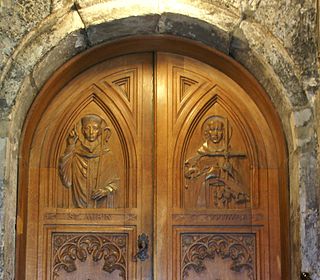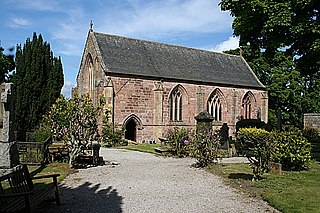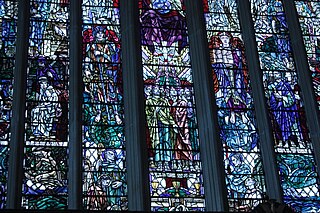
Saint Mirin was born in 565, is also known as Mirren of Benchor, Merinus, Merryn and Meadhrán. The patron saint of the town and Roman Catholic diocese of Paisley, Scotland, he was the founder of a religious community which grew to become Paisley Abbey. The shrine of this saint in the abbey became a centre of pilgrimage.

Saint Duthac was a Scottish Christian prelate who served as Bishop of Ross. He is the patron saint of Tain in Scotland.

St Machar's Cathedral is a Church of Scotland church in Aberdeen, Scotland, located to the north of the city centre, in the former burgh of Old Aberdeen. Technically, St Machar's is no longer a cathedral but rather a high kirk, as it has not been the seat of a bishop since 1690.
Finan of Lindisfarne, also known as Saint Finan, was an Irish monk, trained at Iona Abbey in Scotland, who became the second bishop of Lindisfarne from 651 until 661.
Saint Regulus or Saint Rule was a legendary 4th century monk or bishop of Patras, Greece who in AD 345 is said to have fled to Scotland with the bones of Saint Andrew, and deposited them at St Andrews. His feast day in the Aberdeen Breviary is 17 October.

Saint Blane was a bishop and confessor in Scotland, born on the Isle of Bute, date unknown; died 590. His feast is kept on 10 August.
Saint Fergus was a bishop who worked in Scotland as a missionary.

Saint Moluag was a Scottish missionary, and a contemporary of Saint Columba, who evangelized the Picts of Scotland in the sixth century. Saint Moluag was the patron saint of Argyll as evidenced by a charter in 1544, from the Earl of Argyll, which states "in honour of God Omnipotent, the blessed Virgin, and Saint Moloc, our patron". The House of Lorne became the kings of Dalriada and eventually united with the Picts to become the kings of Scots.

Gavin Dunbar was a 16th-century bishop of Aberdeen. He was the son of Sir Alexander Dunbar of Westfield, near Elgin and Elizabeth Sutherland, apparently a daughter of Alexander Sutherland, Laird of Duffus. Gavin Dunbar, Archbishop of Glasgow, was his nephew.

Douglas Strachan is considered the most significant Scottish designer of stained glass windows in the 20th century. He is best known for his windows at the Peace Palace in The Hague, Netherlands, at Edinburgh's Scottish National War Memorial and in cathedrals and churches throughout the United Kingdom. He is also known for his paintings, murals, and illustrations.

The Aberdeen Breviary is a 16th-century Scottish Catholic breviary. It was the first full-length book to be printed in Edinburgh, and in Scotland.
Religion in Aberdeen is diverse. Traditionally Christianity with the city being represented by a number of denominations, particularly the Church of Scotland through the Presbytery of Aberdeen and the Catholic faith. However, according to the 2001 census, Aberdeen is the least religious city in the country as Glasgow and Edinburgh, with nearly 43% of people claiming to have no religion.
Talarican (Tarkin) was a Scottish Bishop of Sodor of the eighth century.
The Bede House in Old Aberdeen, Scotland, is a 17th-century Scottish town house. It was built in 1676 as a residence for Bailie William Logan and his wife Jean Moir of Stoneywood. During the late 18th century, Old Aberdeen Bedesmen moved from their original hospital beside St Machar's Church to the former Logan house in Don Street. In the 19th century the house changed hands. It was first owned by the Burgh of Old Aberdeen, then, by the City of Aberdeen after the merger of the two burghs in 1891. The house was refurbished by the City of Aberdeen Council in 1965. It was divided into two flats or apartments. The flats are now in private ownership. Much of the 17th-century building is in its original form. It is an excellent example of an L-shaped Scottish Town House, built on three floors with an attic. The house is designated as a Category A listed building.

Bishop Dunbar's Hospital was founded in 1531 by Bishop Gavin Dunbar, the Elder. The hospital was endowed by a mortification just before his death. Dunbar petitioned the King, James V of Scotland, and the charter, signed on 24 February 1531 records the King’s approval that ‘[Dunbar shall] ... found an hospital near the cathedral church, but outside the cemetery...’ It was also known as St Mary's Hospital. In the mortification, Dunbar's charitable purpose is recorded. Bedesmen were supported by a charitable foundation that emerged from the original church control until the twenty-first century. Bedesmen drew their name from the word "bede" - a prayer. The residents of Dunbar's Hospital said prayers in a cycle of Divine Office. The Bede House, Old Aberdeen was used by the Bedesmen from the hospital from 1789 to the end of the nineteenth century. The only remains of the 1531 building can be seen in a perimeter wall for Seaton Park in Old Aberdeen. The last Bedesman died in 1988. The Managers of the Hospital constituted a Charity, Bishop Dunbar Hospital Trust. The Charity ceased active operation in 2012.

Saint Conval (Conwall) was an Irish-born missionary who, according to legend recorded in the Aberdeen Breviary, as he was praying on the sea shore "to be borne, by whatsoever means, to the regions beyond the sea", was miraculously carried by the stone he stood on across the Irish Sea to Inchinnan in Scotland. He was active in the Kingdom of Strathclyde in the area of East Renfrewshire, where there were “Conval wells” in Barrhead and Thornliebank. He is believed to have founded churches at Inchinnan, Pollokshaws and Fereneze. His bones were preserved in an impressive sarcophagus at the Inchinnan church.

Canon Alexander Galloway was a 16th-century cleric from Aberdeen in Scotland. He was not only a Canon of St Machar's Cathedral, he was a Royal Notary and Diocesan Clerk for James IV and James V of Scotland; vicar of the parishes of Fordyce, Bothelny and Kinkell (1516-1552); five times Rector of King's College – University of Aberdeen; Master of Works on the Bridge of Dee in Aberdeen and for Greyfriars Church in Aberdeen; and Chancellor of the Diocese of Aberdeen. According to Steven Holmes, he was one of the most notable liturgists of his time, designing many fine examples of Sacrament Houses across the North-East of Scotland. He was a friend of and adviser to Hector Boece, the first Principal of the University of Aberdeen, as well as Bishop Elphinstone, Chancellor of Scotland and Gavin Dunbar. He was an avid anti-Reformationist being a friend of Jacobus Latomus and Erasmus and clerics in the Old University of Leuven. Along with Gavin Dunbar, Galloway designed and had built the western towers of the cathedral and designed the heraldic ceiling, featuring 48 coats of arms in three rows of sixteen. More than anyone else he contributed to the development of the artistry of Scottish lettering. He has a claim to be what some might call "a Renaissance Man".

St. Lesmo of Glen Tanar is the name given to a holy hermit who it is believed lived in Glen Tanar Aberdeenshire Scotland in the eighth century. He is recorded by Thomas Dempster as a "saint" in the seventeenth century. His claimed Saints’ Day is 9 December.












